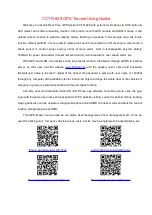
7
4 bytes L: length of this record in bytes (including the T and L fields)
L−5 bytes bytes to ignore (content undefined)
SKIPPER RECORD:
1 byte T: type (always 1)
4 bytes Number of bytes in the file, including and starting at this
record, that contain data for POI enclosed in the given
rectangle
4 bytes X1: longitude coordinate of the west edge of the rectangle
4 bytes Y1: latitude coordinate of the south edge of the rectangle
4 bytes X2: longitude coordinate of the east edge of the rectangle
4 bytes Y2: latitude coordinate of the north edge of the rectangle
SIMPLE POI RECORD:
1 byte T: type (always 2)
4 bytes L: length of this record in bytes (including the T and L fields)
4 bytes X: longitude coordinate of the POI
4 bytes Y: latitude coordinate of the POI
L−13 bytes Name: zero−terminated ASCII string specifying the name
of the POI
EXTENDED POI RECORD:
1 byte T: type (always 3)
4 bytes L: length of this record in bytes (including the T and L fields)
4 bytes X: longitude coordinate of the POI
4 bytes Y: latitude coordinate of the POI
P bytes Name: zero−terminated ASCII string specifying the name
of the POI
Q bytes Unique ID: zero−terminated string specifying the unique ID
of the POI
L−P−Q−13 bytes Extra data: zero−terminated string, not used yet
If you encounter any other type, either the file is corrupt, or the file contains extra (proprietary) records.
In either case, you should stop processing immediately. Since there is always the danger that the file is
corrupt, you should in fact wonder whether the preceding records read so far were in fact valid.
2. Providing your own Points of Interest to TomTom Navigator









































